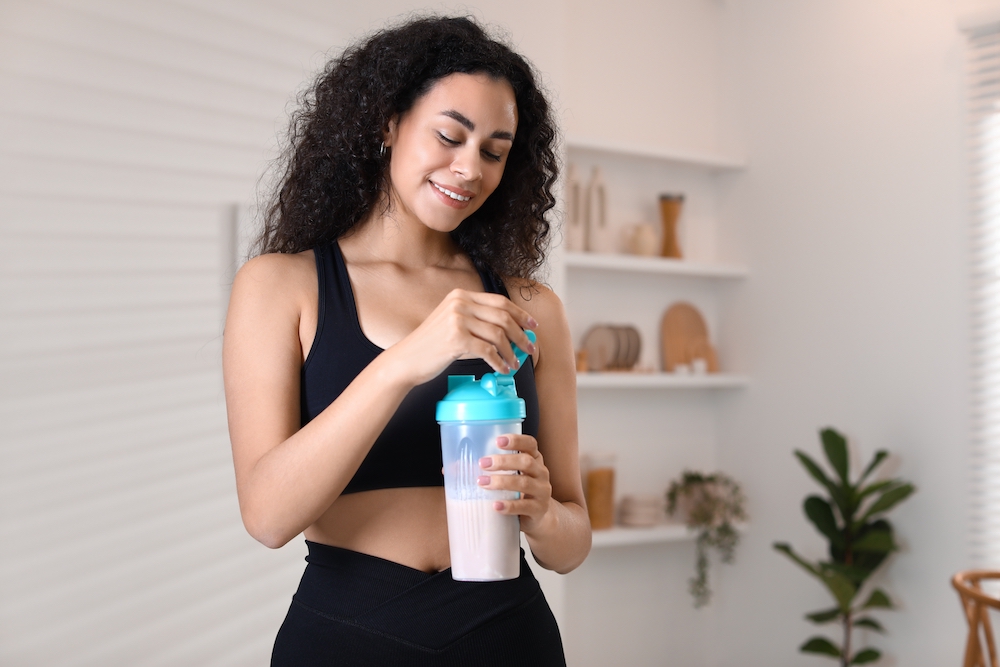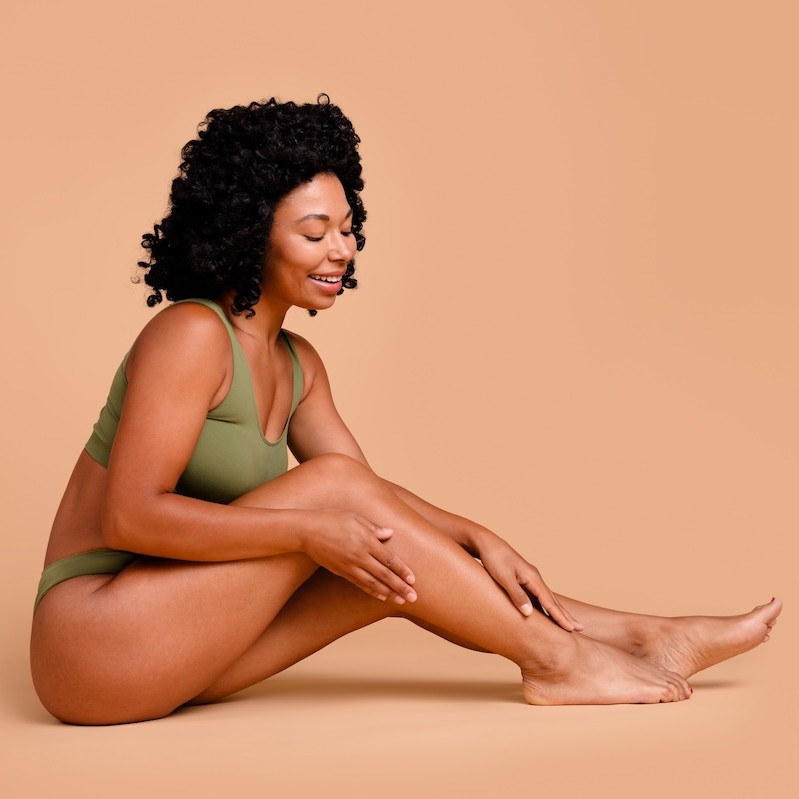The supplement boom shows no signs of slowing – but knowing which products genuinely improve skin from within is key
Here’s how to guide clients through collagen, probiotics, multivitamins and more, with expert insights on the safest, most effective combinations for glowing, healthy skin.
How can supplements benefit your skin?
“Ingestible supplements leverage your biology to influence your skin from within,” explains Lauren Dewsbury, senior research scientist and product formulator at Vida Glow.
“The key benefit to taking a supplement is that they have a systemic effect in your body [as opposed to a local effect with topicals], meaning you are improving skin health at the cellular level.”
However, the effect of supplements is more than skin deep, as Lorraine Perretta, Advanced Nutrition Programme’s head of nutrition, explains.

“They do much more for skin than just making it look good. The body makes 200 million skin cells every hour – cells that are not made from topical creams or serum, but from the food we eat and the supplements we take,” she says.
“As we know, the skin is the largest organ of the body and is a two-sided organ. Creams and treatments only do half the job by benefitting the skin from the outside. By adding supplements, you are feeding the skin from the inside and achieving 100% skincare.”
What form of supplement is most effective?
With supplements readily available as capsules, tablets, gummies, liquids and even in the form of IV drips, it can be hard to know what’s going to be the most effective choice.
“It really depends on the ingredients in the formula and what you are trying to achieve,” shares Dewsbury. “Supplements can be purchased in a variety of different formats; however, these formats vary in how well they can get the job done. When we formulate a product, we consider the active ingredients, their bioavailability and where they need to be delivered to in the body – this will dictate the format we use.

“For example, for collagen supplements, powdered collagen peptides offer the best bioavailability and maximum absorption. However, other ingredients, like probiotics, are much more sensitive to heat and moisture and are best delivered in capsule form.”
As a general rule of thumb, Perretta notes that capsules can supply vitamins in the cleanest form. “Quality capsules dissolve within three-to-five minutes, releasing their contents in the stomach ready for absorption along with a meal,” she adds.
However, when advising clients on the best supplements for them, you also need to consider their lifestyle, says Amy Masser, Registered Associate Nutritionist and a nutritionist at Feel. “Beyond bioavailability, what actually matters is sticking to a routine,” she stresses.
“Capsules are brilliant for precision and convenience, especially when you don’t need large doses.
“Powders work well when you want a bigger serving or enjoy the ritual of mixing something each day, which is why collagen, greens and electrolytes often come in that format.
“Meanwhile, liquids and gummies can be great for people who struggle with capsules, but they usually have lower active doses and more sweeteners, so it’s about choosing what you’ll genuinely stay consistent with.”
How to choose the right supplements
From activated charcoal to zinc, there are so many supplements available it can be hard for your clients to know where to begin.
For supplement newbies, Perretta suggests a targeted multivitamin plus a probiotic to support the gut microbiome. “Many people notice the benefits just from adding these two products,” she notes.
Beyond that, it’s important to understand the goals your client is looking to achieve. “Your client’s ingestible beauty supplement routine should be based around their key beauty concerns or goals,” explains Dewsbury.
“If your client is new to ingestible beauty, I would recommend starting by introducing just one product at a time and building their routine from there. This way they know what is working for them, it streamlines their routine and is kinder to their bank balance.”

With any ingestible treatment, Perretta recommends a combined approach. “For the best results when targeting specific skin concerns, including eczema, acne, dehydrated skin and pigmentation as well as lines and wrinkles, skincare professionals should be trained in identifying the skin condition and recommending specific science-backed supplements to synergise with appropriate treatments and home care,” she says.
The best supplements to take together
Pairing up supplements is a great way to boost the effects and target multiple concerns. “It’s all about giving your body combinations that enhance each other rather than relying on single ingredients in isolation,” explains Masser.
“When you think about food, it contains dozens of different nutrients as well as proteins, fats and carbohydrates, so the body knows how to digest and absorb them,” says Perretta. Your body will treat supplements in the same way.
“In fact, vitamins like to work with each other in synergy. For example, vitamin A requires zinc as a co-factor in order to convert to the active form for skin,” adds Perretta.
“The best way for someone to ensure they have all the co-factors for optimum synergy is to have a daily multivitamin as the foundation product for every supplement routine.”
Which nutrients should women prioritise during perimenopause and menopause?
“This is the stage where the right nutrients make a real difference”, says Masser.
Here are her top recommendations:
- Magnesium – supports sleep and stress
- Omega 3 DHA and EPA – helps with mood and cognitive clarity
- B vitamins (especially B6, B12, and folate) – help keep energy levels steady
- Collagen – as production drops with age
- Collagen and calcium paired together – support bone strength
- Probiotics – as gut health can affect hormone metabolism, bloating and mood
Can you take too many supplements?
It’s easy for clients to get carried away with supplements – a gummy here, a capsule there, a shot to start their day – but is there a risk of doing more harm than good?
“While supplements are generally very safe and pose little health risk when taken appropriately, you can have too much of a good thing,” explains Dewsbury. “Exceeding the daily upper limits for various micronutrients [like iron, selenium, or zinc] can be unsafe and lead to side effects, so it’s important to know what you’re taking and not to double up.”

“It usually happens accidentally,” says Masser. “People mix multiple products without realising they contain the same nutrients, like taking a multivitamin alongside two different magnesium blends.”
Dewsbury suggests advising clients to check the ingredients list on their supplement labels to make sure the same ingredient is not found in multiple supplements, adding, “The limits vary between different ingredients, ages and sexes, but there are Government guidelines available to help consumers understand the recommended daily intakes of various vitamins and minerals and what is right for them.”
Don’t worry if your supplements do have some crossover, though, as Perretta adds, “Overdosing with vitamin supplements is extremely rare. If someone wishes to take multiple supplements with overlapping nutrients, they should contact the manufacturers or their healthcare practitioner for advice. It may be advisable to stick to one brand as they will have developed the range so their supplements can be taken together.”
Before you place an order for every supplement under the sun, there are some key elements to remember, as Dewsbury explains, “Ingestible beauty supplements are a marathon, not a sprint.”
Adding new supplements is not unlike adding new products to your skincare routine. “You are helping clients to improve their skin from within, and this takes time and consistency. They need to stick with it for at least three months to ensure they are getting the most out of it, then decide whether it is right for them. Introduce one product at a time so they can clearly see what is working for them.”
Choosing your supplement supplier
When it comes to picking a brand, Perretta recommends that you “look for a clean label without flavourings, sugar, salt or gluten”, adding, “The manufacturer should be transparent about source of ingredients, sustainability and environmental sensitivity.”
Perhaps the most important thing when it comes to making a choice on which supplements to choose is to pick a brand you trust. Dewsbury explains, “Supplements can vary dramatically in their quality and efficacy. Look for products that are supported by scientific evidence, so you know they are going to do what they say they’re going to do.”
FAQs: Supplements and Skin Health
1. Do supplements really improve skin health?
Yes. Skin supplements can support healthier skin by delivering nutrients to the body systemically rather than topically. Ingredients like collagen peptides, omega-3s, probiotics, and targeted vitamins can help improve hydration, elasticity, brightness and overall skin resilience when taken consistently.
2. What are the best supplements for glowing skin?
Commonly recommended supplements for glowing skin include collagen peptides, vitamin C, zinc, omega-3 fatty acids, and probiotics. A high-quality multivitamin can also provide the foundational nutrients the skin needs to regenerate effectively.
3. Can you take collagen with other supplements?
Yes. Collagen pairs well with vitamin C, zinc, hyaluronic acid supplements, omega-3s, and multivitamins. These combinations can help enhance collagen synthesis, improve absorption, and support overall skin health.
4. Which supplements should not be taken together?
Most vitamins and botanicals are water soluble, so the body naturally uses what it needs and clears the rest, but fat soluble vitamins like A, D, E and K can build up over time, as can minerals like iron, zinc and calcium if you’re doubling up. Combining high doses of these micronutrients can cause side effects. Always check product labels or consult a qualified professional when unsure.
5. What supplements are best for perimenopause and menopause skin concerns?
Key supplements for this life stage include magnesium (for sleep and stress), omega-3 DHA/EPA (for mood and cognitive clarity), B vitamins (for energy), collagen (as natural production declines), calcium (for bone health), and probiotics (for gut and hormone support).
6. How long does it take for skin supplements to work?
Most experts recommend taking skin supplements consistently for at least 8–12 weeks. This allows enough time for the body to regenerate new skin cells and for nutrient levels to build up. Some clients may see benefits sooner depending on the ingredients and their individual needs.
7. Are gummies as effective as capsules or powders?
Gummies can be easier to take, but they often contain lower active doses and added sweeteners. Capsules typically deliver cleaner, more precise amounts of nutrients, while powders are ideal for larger servings like collagen or greens blends.
8. Can you take multiple supplements at the same time?
Yes, many supplements work synergistically – for example, vitamin A with zinc, or collagen with vitamin C. A quality multivitamin makes an excellent foundation for combining additional targeted supplements safely.
9. Are supplements safe to take every day?
Most skin and wellness supplements are safe for daily use when taken as directed. Issues usually arise when clients unknowingly combine multiple products containing the same nutrients. Checking labels and sticking to trusted brands helps ensure safe, effective routines.

hero-lg.jpg)

square.JPG)
